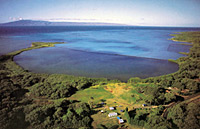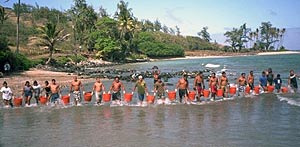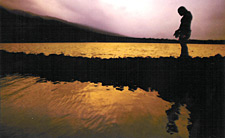Contact EPA Pacific Southwest Water Division
Pacific Southwest, Region 9
Serving: Arizona, California, Hawaii, Nevada, Pacific Islands, Tribal Nations
Project Loko I'a: Restoring Hawai'i's Traditional Fish Ponds
Related Information
- EPA Office of Water
- EPA's National Coral Reef Protection Web site
For information on coral reef conservation activities - U.S. Coral Reef Task Force (CRTF) Established to lead the U.S. response to the growing global coral reef environmental crisis
- EPA's Oceans, Coasts and Estuaries Web site
- EPA's Pacific Island Contact Office (PICO)

Aerial view of Keawanui Fishpond, Molokai
On this page:
Most people go to the supermarket for their seafood, increasingly, in Molokai and other parts of Hawai'i, some lucky residents can get their fish and limu (seaweed) grown from a local pond. In addition, residents in Hawai'I and on the mainland are now seeing beautiful "live rock" for sale in their local aquarium stores and can be pleased to know that this man-made alternative is the perfect antidote to illegal coral mining.
A revival of traditional aquaculture techniques has been ongoing for several years in Hawai'i. Project Loko I'a [pronounced Loko ee-ya] a fishpond restoration project started in 1999 with EPA assistance and has yielded successful results that has assisted others in Hawai'i to begin their own fishpond restoration efforts. For many Hawai'ians, fishpond restoration is seen as an important step toward a sustainable future and a way to preserve an important part of Hawai'ian culture.
In September 2004 a statewide fishpond conference of fishpond operators was held at He'eia Fishpond, Oahu. The conference was sponsored by Project Loko I'a and Paepae o' He'eia. Over 70 people representing fishpond operators, non-profit foundations, government officials, educators, scientists, entrepreneurs and interested community members attended the two day event.
These groups, from Molokai Hui o Kuapa, the Hawaiian Learning Center located at Keawanui Fishpond, from Oahu, Paepae o' He'eia, and from Maui Ao'ao Na Loko I'a o Maui at Ko'ie'ie Fishpond see themselves as a resource on their respective islands to help others who are interested in restoring fishponds.
Hawai'i fishpond history

Restoring the Kahinapohaku Fishpond
In ancient Hawai'i, fishponds were an integral part of the ahupua'a, the land area that stretched from the mountains to the coral reefs. The Hawai'ians built rock-walled enclosures in near shore waters, to raise fish for their communities and families. More than 75 of these ponds were believed to have been in production at one time or another on the island of Molokai alone, with the latest estimates as high as 488 statewide.
As Hawai'i agricultural system began to focus on cash crops, fishpond use declined. In some cases, the fishponds became significantly contaminated by polluted runoff from urbanization, overgrazing, and agricultural production. It is estimated that up to 95% of these ponds require some level of restoration.
Reviving the past
Hawai'ian communities have taken the initiative to restore the fishponds and revive aquaculture in the State. Since October of 1999, Congress allocated over $1.4M to restore fishponds and to analyze water quality impacts, beginning on the island of Molokai.
Previously, a fishpond owner was faced with the difficult journey of navigating through the many permits needed to restore a fishpond. Federal and state agencies, fishpond owners and operators, and community members have recently developed a more streamlined approach that can help the owner/operator meet the needed requirements in a more reasonable time period.
Project Loko I'a sought to find or help define a lead agency within the State of Hawai'i during this project period. However, with fewer resources available within the State, this effort was not successful. With this in mind, organizations statewide have started to share their experiences and information to help each other through the approval processes.
Back to the future

Fishponds are important to the Hawaiian culture
Thirteen fishponds have been restored statewide, with six ponds currently in use; three on Molokai, one on the island of Hawai'i, and two on Oahu. Through Project Loko I'a, the Hawai'ian Learning Center at the Keawanui fishpond on Molokai has been established and provides the local, state, aquaculture and research community an opportunity to view, discuss and experience a working fishpond and demonstration ahupa'a. The strategic plan also calls for continued education and research in fishpond management, aquaculture, ecosystems, and water quality, business/marketing and Hawaiian culture.
A team of Molokai youths have gained much from this experience, by developing business plans, learning ancient wall building techniques, identifying and working to streamline permit requirements, and monitoring the ponds water quality. Their expertise is being used to work with other communities to restore additional fishponds throughout the State.
In addition, Keawanui is the Molokai field site for teacher training and in 2005, will be hosting students using the Kahea Loko (Call of the Fishpond) Curriculum. Project Kahea Loko is funded by the U.S. Department of Education and focuses on the development of culturally relevant curricula using the fishponds to teach science, social studies and language arts to students in grades four to twelve.
For more information
View the full report and other information:
- Loko I'a Report (PDF) (83 pp, 5.6MB About PDF)
- Analysis of water quality data (PDF) (42 pp, 410K About PDF)
- Fishpond regulatory permit guide (PDF) (12 pp, 68K About PDF)
- Permit forms (PDF) (10 pp, 45K About PDF)
Project partners
Hawaiian Learning Center
P.O. Box 486
Kaunakakai, HI 96748
phone (808) 558-0111
Farber and Associates
2722 Ferdinand Ave.
Honolulu, HI 96822
phone (808) 988-3486
Professor of Civil and Environmental Engineering
346 Holmes Hall
Univ. of Hawaii at Manoa
Honolulu HI 96822
phone (808) 956-7298
EPA Contact
Susan Polanco de Couet (polanco.susan@epa.gov)
phone (808) 541-2722
